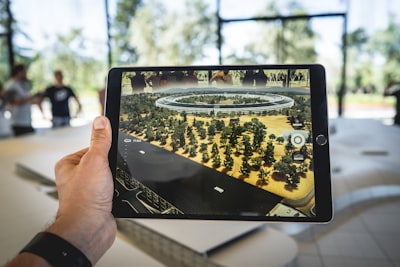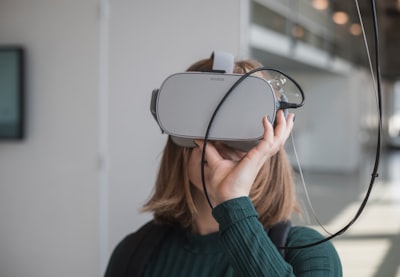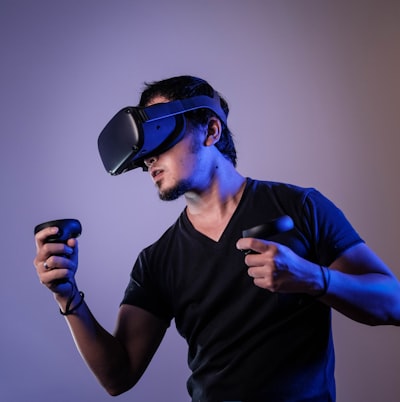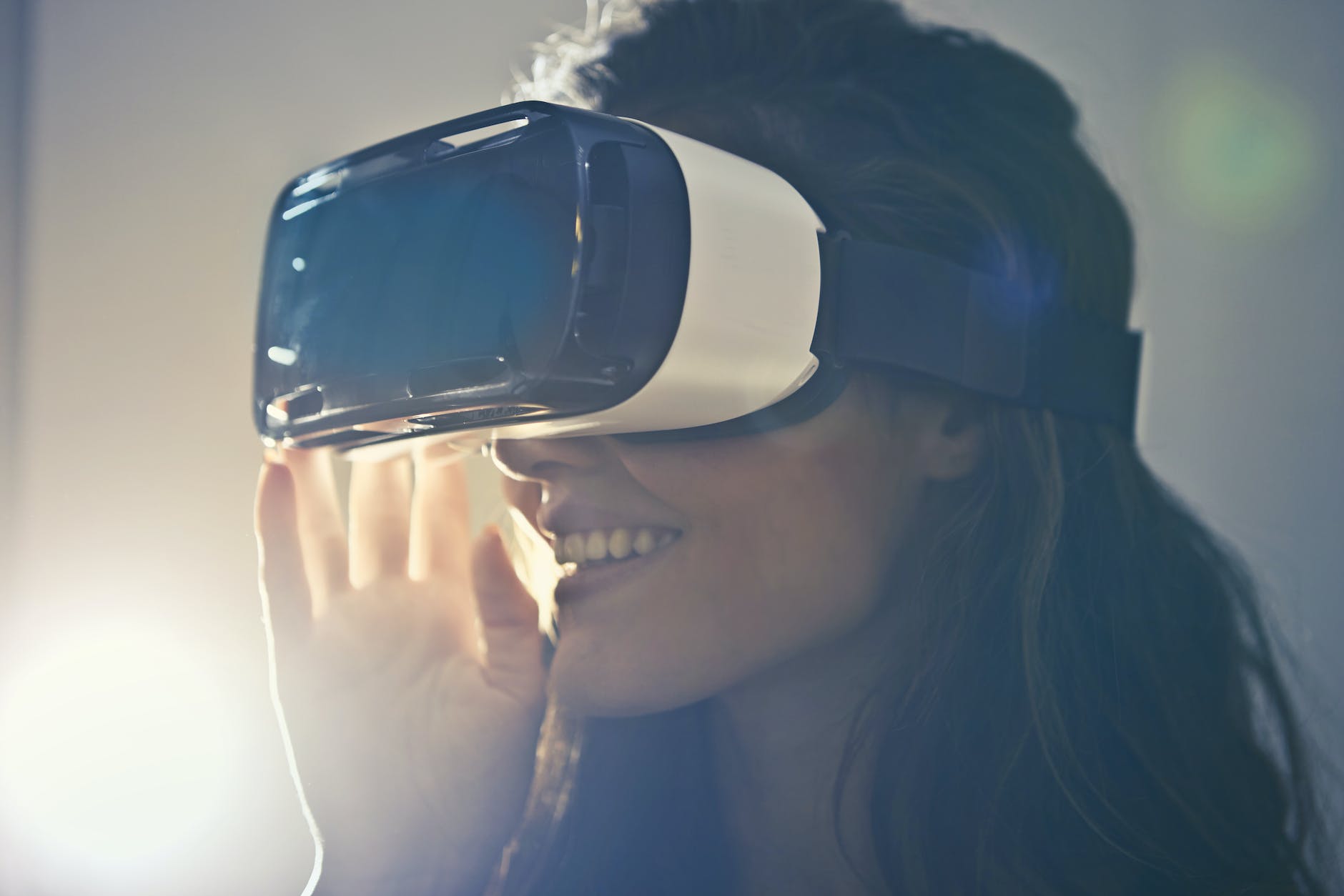
Augmented Reality Creation Tools: Unleashing Creativity
Are you ready to unleash your creativity and dive into the exciting world of augmented reality? Augmented reality (AR) is revolutionizing various industries, from healthcare to education and beyond. In this blog, we will explore the different types of augmented reality applications and delve into the top 10 AR creation tools that you should consider using, including ar sdk.
From Vuforia to ARCore, we will discuss their pros and cons, helping you make an informed choice. But it doesn’t stop there! We will also take a look at where AR is being implemented in healthcare, business, and education. Additionally, we will highlight the benefits of using the free version of AR creation tools and provide valuable insights on how to use them effectively. Get ready to bring your imagination to life with augmented reality!

Types of augmented reality apps
Augmented reality (AR) has revolutionized the way we perceive and interact with the virtual world around us. It offers a plethora of applications that seamlessly blend virtual elements into our reality. From marker-based AR, which relies on physical markers to trigger AR experiences, to markerless AR that uses computer vision algorithms, there are numerous ways to explore this technology.
Projection-based AR takes it a step further by projecting virtual images onto real-world surfaces, creating mesmerizing visual effects. Superimposition-based AR enhances our surroundings by overlaying virtual objects, adding a touch of magic and imagination. Location-based AR harnesses the power of geolocation, GPS, and location-tracking technologies to provide contextually relevant information based on our whereabouts.
And let’s not forget gesture-based AR, which enables us to interact with AR content using hand gestures and body movements, making the experience more immersive and enjoyable. With these various types of AR applications, possibilities are endless as we unlock new dimensions of creativity in virtual reality.
10 best augmented reality creation tools to consider
Augmented reality creation tools offer a plethora of options for developers to unleash their creativity and build immersive AR experiences. These tools cater to various platforms like iOS, Android, and even smart glasses. Some of the top-notch AR tools worth considering include Unity, ARKit, Vuforia, Spark AR Studio, and Lens Studio. These powerful tools provide features like marker-based tracking, motion tracking, and image recognition that enable developers to bring their AR visions to life. With SDKs and APIs readily available, these tools simplify the process of AR app development, making it accessible to developers of all skill levels.
1. Vuforia
Vuforia, a renowned augmented reality platform, empowers users to craft engaging AR experiences. This powerful tool boasts cutting-edge functionalities like object recognition, image tracking, and virtual buttons. It seamlessly integrates with popular development tools such as Unity and Unreal Engine, making it a go-to choice for AR app creation.
Leveraging Vuforia’s exceptional tracking capabilities, developers can seamlessly superimpose virtual content onto real-world objects, resulting in immersive mixed reality experiences. The platform also provides a cloud recognition service, allowing for real-time tracking and identification of specific images or objects. With its extensive feature set and intelligent tracking capabilities, Vuforia leads the way in augmenting reality software development.
Pros and Cons
Some of the good things about Vuforia include its robust tracking capabilities, seamless integration with popular development tools, its cloud recognition service, and the power of the Vuforia Engine. These features enable developers to create highly immersive AR experiences and provide real-time tracking and identification of specific images or objects.
However, there are also some limitations to consider. One drawback is that Vuforia’s advanced features may require a steep learning curve for beginners. Additionally, the platform’s pricing structure can be a bit complex, especially for projects with higher usage requirements.
2. Wikitude
Wikitude, an augmented reality (AR) platform, provides users with the ability to create and publish their own AR experiences. Leveraging image recognition, location-based AR, simultaneous localization, and 3D object tracking, Wikitude delivers a user-friendly interface for developing interactive AR content.
The intuitive drag-and-drop functionality and customizable templates allow users to easily generate captivating AR experiences even without extensive coding expertise. Moreover, developers can access Wikitude’s software development kit (SDK) for advanced customization and seamless integration with other applications and platforms. From marketing campaigns to educational initiatives, businesses, educators, and developers have harnessed Wikitude to realize their AR visions.
Pros and Cons
The best thing about Wikitude is its user-friendly interface and drag-and-drop functionality, which make it accessible to users without extensive coding experience. This means that even beginners can easily generate captivating AR experiences. Additionally, Wikitude offers customizable templates that further simplify the development process, making it a great choice for saas.
Another advantage of Wikitude is its wide range of features, including image recognition, location-based AR, simultaneous localization, 3D object tracking, and integration with Facebook. These features provide developers with a toolkit to create highly interactive and immersive AR content.
However, one limitation of Wikitude is that it may not be as robust or advanced as some other AR development tools.
3. ARKit
ARKit, developed by Apple, is a game-changer in the field of augmented reality (AR) creation tools. This software development kit (SDK) is specifically designed for iOS devices, providing developers with a wide range of tools and resources to create immersive AR experiences. With ARKit, developers can seamlessly integrate virtual content like 3D models and animations into the real world, harnessing the power of advanced computer vision techniques.
Real-time motion tracking ensures that virtual objects interact convincingly with the physical environment, while features like face tracking enable the creation of interactive AR experiences using the front-facing camera. ARKit is the go-to choice for developers in the gaming, education, and marketing industries, revolutionizing the way we interact with the digital world. The iPhone is the primary device that supports ARKit, making it accessible to millions of users worldwide.
Pros and Cons
The pros of using ARKit are its advanced computer vision techniques and seamless integration with iOS devices. This makes it a powerful tool for creating highly immersive and interactive AR experiences. Additionally, the real-time motion tracking and face tracking features open up a world of possibilities for developers in various industries, including subscription-based services.
However, one limitation of ARKit is its exclusivity to iOS devices. This means that developers targeting a wider audience or those who prefer working on other platforms may need to consider alternative tools. Additionally, while ARKit offers a robust set of features, it may not have the same level of customization and flexibility as some other AR development
4. ARCore
ARCore, developed by Google, offers a powerful set of tools and APIs for creating augmented reality experiences on Android devices. With features like motion tracking, environmental understanding, and light estimation, ARCore allows developers to build highly realistic and immersive AR apps and games.
This platform caters to a broad user base, including smartphone and tablet users. Regular updates and constant feature additions ensure that ARCore stays at the forefront of reality development and AR technology. Whether you’re an experienced developer or just starting out, ARCore provides the tools you need to bring your AR ideas to life.
Pros and Cons
ARCore offers numerous benefits for developers looking to create augmented reality experiences on Android devices. Some of the pros include the fact that it has many advanced features like motion tracking, environmental understanding, and light estimation. These features allow for highly realistic and immersive AR experiences. Additionally, ARCore is constantly being updated and improved, ensuring that developers have access to the latest advancements in AR technology.
However, there are some potential limitations to keep in mind. For one, ARCore is limited to Android devices, so if you’re looking to create AR experiences for iOS or other platforms, you will need to consider alternative tools. Additionally, while ARCore is relatively user-friendly, there may still be a learning curve for beginners who are new to AR development.
5. MaxST
MaxST, an advanced augmented reality creation tool, empowers users to develop immersive AR experiences. With real-time 3D tracking and mapping capabilities, it enables the seamless integration of virtual objects into the real world. MaxST’s compatibility with iOS and Android platforms makes it widely accessible. The tool’s additional features, such as image recognition and markerless tracking, enhance the complexity and interactivity of AR projects. Boasting an intuitive interface and comprehensive documentation, MaxST caters to beginners and seasoned developers alike.
Pros and Cons
MaxST offers numerous benefits for developers looking to create augmented reality experiences. One of the pros is its advanced real-time 3D tracking and mapping capabilities, which allow for seamless integration of virtual objects into the real world. This creates highly immersive and interactive AR experiences. Another advantage is MaxST’s compatibility with both iOS and Android platforms, making it widely accessible for developers working on different devices.
However, like any tool, MaxST does have some potential drawbacks. One limitation is that while MaxST offers a user-friendly interface, there may still be a learning curve for beginners who are new to AR development. Additionally, MaxST’s advanced features and capabilities may require more technical expertise and experience to fully utilize.
6. EasyAR
EasyAR is a robust and user-friendly augmented reality creation tool that empowers developers to craft immersive AR experiences. Its intuitive interface and comprehensive range of features make it a top choice for both beginners and experienced developers. Whether you’re building an AR app for iOS or Android, EasyAR has you covered.
From marker-based tracking to image recognition and 3D object tracking, EasyAR provides all the necessary tools to bring your virtual creations to life. Moreover, its cloud recognition and cloud augmentation capabilities enable users to seamlessly store and access AR content from the cloud. With its extensive documentation and tutorials, EasyAR ensures a smooth and efficient development process.
Pros and Cons
When it comes to augmented reality creation tools, EasyAR stands out as a robust and user-friendly option. Its intuitive interface and comprehensive range of features make it a top choice for developers of all levels of experience. Whether you’re just starting out or have years of AR development under your belt, EasyAR has something to offer.
One of the key advantages of EasyAR is its versatility. It supports both iOS and Android platforms, allowing developers to create AR experiences for a wide range of devices. From marker-based tracking to image recognition and 3D object tracking, EasyAR provides all the necessary tools to
7. Kudan
Kudan is an augmented reality (AR) tool that revolutionizes the creation of interactive AR experiences. This cutting-edge AR software allows users to effortlessly place virtual objects into the real world without relying on physical markers. With its markerless tracking capability, Kudan opens up a world of creative possibilities. It also boasts advanced image recognition capabilities, empowering users to craft AR experiences that seamlessly respond to specific images or objects.
Not stopping there, Kudan supports robust 3D object tracking, enabling users to precisely anchor virtual objects to any real-world surface and seamlessly track their movements. With its intuitive user interface and extensive documentation and tutorials, Kudan simplifies the AR creation process, making it accessible to both seasoned developers and beginners alike.
Pros and Cons
Some of the pros of using Kudan include its markerless tracking capability, advanced image recognition features, and robust 3D object tracking. These features allow for more freedom and creativity in creating AR experiences. Additionally, Kudan provides an intuitive user interface and comprehensive documentation and tutorials, making it accessible to developers of all skill levels.
However, there are also a few cons to consider when using Kudan. One potential drawback is that it may require more computational power compared to other reality creation tools. This means that devices with lower processing capabilities might struggle to run AR experiences created with Kudan smoothly.
8. ARToolKit
ARToolKit, an open-source software library, empowers developers to create augmented reality applications effortlessly. This powerful tool supports multiple platforms, including Windows, Mac, iOS, Android, and Linux, offering flexibility and accessibility to a wider audience.
With features like marker detection, camera calibration, and 3D object rendering, ARToolKit equips developers with the necessary tools to craft immersive AR experiences. Its user-friendly interface and comprehensive documentation ensure that beginners and experienced developers alike can easily utilize its potential. Trusted by developers worldwide, ARToolKit has made its mark in various industries, from education to marketing campaigns, making it a versatile and reliable resource for AR development.
Pros and Cons
ARToolKit offers several advantages for developers. Firstly, its open-source nature enables collaboration and customization, allowing developers to tailor the tool to their specific needs. This flexibility is further enhanced by ARToolKit’s compatibility with multiple platforms, making it accessible to a wider range of users.
One of the standout features of ARToolKit is its marker detection capability, which enables accurate tracking of physical objects and surfaces. This allows for precise placement and interaction within the augmented reality environment, enhancing the overall user experience. Additionally, ARToolKit’s camera calibration feature ensures that AR content aligns seamlessly with the real world
9. ARmedia
ARmedia, an innovative augmented reality creation tool, empowers users to unleash their creativity and build immersive experiences across multiple platforms, including iOS, Android, and Windows. With its powerful features like 3D object tracking, markerless tracking, and image recognition, ARmedia opens up a world of creative possibilities.
Users can effortlessly bring their ideas to life with real-time previewing and editing, ensuring seamless visualization of their augmented reality projects. Whether you’re a beginner or an expert, ARmedia’s intuitive interface and comprehensive documentation enable seamless adoption and exploration of augmented reality technology. Step into the future of AR creation with ARmedia.
Pros and Cons
ARmedia offers numerous benefits to developers and creators. Firstly, its compatibility with multiple platforms makes it a versatile tool that can reach a wider audience. Whether you’re using iOS, Android, or Windows, ARmedia has got you covered.
Additionally, ARmedia’s powerful features such as 3D object tracking, markerless tracking, and image recognition make it a robust tool for creating immersive augmented reality experiences. These features allow users to bring their creative ideas to life and engage their audience in unique ways.
On the downside, ARmedia may have a steeper learning curve for beginners unfamiliar with augmented reality development.
10. DeepAR.ai
DeepAR.ai is an advanced augmented reality creation tool that enables users to create immersive AR experiences. Leveraging cutting-edge technologies like face tracking, object recognition, and 3D modeling, DeepAR.ai empowers users to enhance their AR projects. With its compatibility for both iOS and Android platforms, DeepAR.ai reaches a wider audience and ensures a seamless user experience.
The tool allows users to incorporate interactive elements such as filters, animations, and effects, enabling the creation of captivating AR content. Comprehensive documentation and support further facilitate the creative process, making DeepAR.ai a valuable choice for developers and enthusiasts alike.
Pros and Cons
DeepAR.ai offers a range of advantages for creators and developers. Firstly, its advanced technologies such as face tracking and object recognition allow for highly interactive and engaging AR experiences. Users can incorporate filters, animations, and effects to create captivating content that resonates with their audience.
Additionally, DeepAR.ai’s compatibility with both iOS and Android platforms ensures that the created AR experiences can reach a wider user base. The tool also provides comprehensive documentation and support, making it accessible even to those who are new to augmented reality development.
However, one potential drawback of DeepAR.ai could be its complexity for beginners.
Where to find AR
Ready to discover the world of Augmented Reality Creation Tools? There are various paths you can take to find the perfect fit for unleashing your creativity. One option is to explore app stores and online marketplaces, which offer a wide range of AR tools and applications. Another avenue is to immerse yourself in AR development communities and forums, where seasoned creators can provide valuable recommendations and insights.
Additionally, consider exploring popular AR platforms and software that provide extensive creative capabilities. If you’re looking for a customized AR experience, you can always enlist the skills of a professional developer or agency. For those seeking more advanced options, open-source AR frameworks and libraries can offer boundless opportunities. To stay ahead of the curve, keep a keen eye on industry news and events, which can provide a gateway to discovering the latest AR tools and technologies.
Augmented Reality in Healthcare: the Multifaceted Opportunities You Need to Know About
In the healthcare industry, Augmented Reality (AR) is revolutionizing medical training, patient education, surgical procedures, and telemedicine. With AR, healthcare professionals can create realistic virtual environments for practicing procedures, empowering them to enhance their skills and knowledge.
Patients can also benefit from AR, as they gain a better understanding of their medical conditions and treatment options through interactive visualizations. Surgeons can leverage AR to improve surgical accuracy and efficiency by accessing real-time guidance and overlaying important information onto their field of view. Telemedicine is transformed by AR, facilitating remote consultations with augmented visuals. The multifaceted opportunities of AR in healthcare are reshaping the industry and improving patient outcomes.
Try out these other Articles: Augmented Reality Apps

Augmented Reality for Business: Benefits and Applications
Augmented Reality (AR) has revolutionized the way businesses engage with their customers and showcase their products. With the increasing accessibility of AR tools and platforms, businesses can now leverage innovative AR experiences to drive customer engagement and boost sales. Whether it’s through virtual try-on experiences for fashion and beauty products or interactive product demos, AR provides businesses with a unique opportunity to create immersive brand experiences.
By integrating AR into their marketing strategies, businesses can take advantage of improved product visualization, allowing customers to see how products would look in their own environment. This not only helps customers make informed purchasing decisions but also enhances their overall shopping experience.
Additionally, AR can be used to offer virtual tours of real estate properties, allowing potential buyers to explore properties remotely and make more informed decisions.
One of the key advantages of using AR creation tools is the ability to create gamified marketing campaigns. By incorporating AR elements into campaigns, businesses can captivate their audience and enhance brand recall. From scavenger hunts to interactive AR games, businesses can tap into the power of augmented reality to create memorable experiences for their customers.
AR creation toolkit for professionals
Create captivating augmented reality (AR) experiences with the help of AR creation tools for professionals. These tools, such as Unity, Unreal Engine, and Vuforia, provide the necessary features to develop interactive and immersive AR content. Unity, a widely-used game development platform, offers a range of capabilities for stunning AR experiences.
Unreal Engine, known for its advanced tools, allows for the creation of high-quality and realistic AR content. Vuforia, an SDK supporting both iOS and Android platforms, ensures seamless AR app development. With image recognition and object tracking, these tools are ideal for professionals looking to bring their AR visions to life.

AR and VR in Education
Augmented Reality (AR) has found its place in education, revolutionizing traditional learning methods. By integrating AR technology into educational apps and platforms, students are now able to experience a new dimension of learning.
With the ability to interact with virtual objects and environments, AR enhances student engagement and information retention across subjects like science, geography, history, and art. Instructors have the flexibility to create customized AR content using specialized software or readily available resources online. The introduction of AR in education has proved to be a game-changer, empowering students to learn in a more immersive and interactive way.
Benefits of using AR creation tools
By leveraging AR creation tools, you can unlock endless possibilities in bringing virtual elements into the real world, igniting creativity, and fostering user engagement. These cutting-edge tools offer interactive and immersive experiences that transcend traditional storytelling, enabling the seamless creation of immersive narratives.
With applications spanning across industries such as education, gaming, marketing, and retail, AR creation tools provide a cost-effective avenue for incorporating augmented reality into your projects, even without extensive programming knowledge.
Equipped with features like image recognition, object tracking, and virtual buttons. These versatile tools empower professionals to craft captivating AR experiences. Embrace the power of AR creation tools to craft awe-inspiring content. That captivates your audience and unravels the boundless potential of augmented reality.
How to use AR creation tools effectively?
To effectively use AR creation tools, first, familiarize yourself with their features. Then, plan your project by defining the desired user experience and objectives. Experiment with various elements like 3D models and animations. Finally, test your creation on multiple devices for compatibility and a great user experience.
Conclusion
Augmented reality (AR) is a powerful tool for unleashing creativity and bringing imagination to life. To choose the right AR creation tools for your needs. Consider the 10 best options: Vuforia, Wikitude, ARKit, ARCore, MaxST, EasyAR, Kudan, ARToolKit, ARmedia, and DeepAR.ai. These tools have their pros and cons, so explore them further to find the perfect fit for your projects.
be sure to follow on Instagram.

